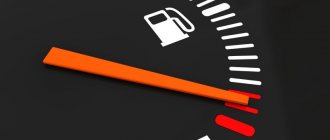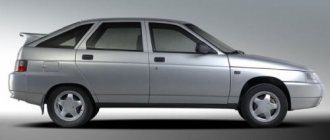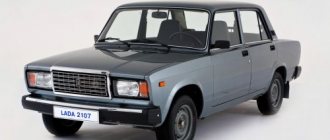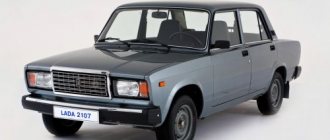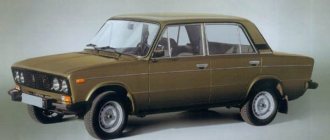How to calculate gasoline consumption per 100 km?
Any driver is interested in the question of how many liters of gasoline his car “eats.” Reading the characteristics of a particular model, we see fuel consumption, which shows how much gasoline the engine needs to travel 100 kilometers in the urban or extra-urban cycle, as well as the arithmetic average of these values - fuel consumption in the combined cycle.
Nominal and actual fuel consumption may differ, usually not very significantly.
- technical condition of the car - while the engine is being run-in, it consumes more fuel, then the consumption level decreases to the norm specified in the instructions, and as it wears out it increases again;
- riding style is an individual matter for each individual;
- weather conditions - in winter the engine consumes more fuel, in summer - less;
- use of additional energy consumers;
- aerodynamics - when the windows are open, the aerodynamic properties decrease, air resistance increases, and accordingly more gasoline is needed;
- aerodynamic properties can be improved by installing spoilers and streamlined elements.
You are unlikely to be able to calculate the exact standard fuel consumption values, down to the milliliter, but you can calculate the approximate consumption for different driving conditions very simply, you don’t need to be a great mathematician for this, you just need to remember the mathematics course for the third or fourth grade and know that these are the proportions.
The calculation formula used by flow calculators is very simple:
Divide the displacement by the mileage and multiply by one hundred - l/km * 100.
How to reduce fuel consumption on a VAZ 2109 carburetor
If you have high fuel (gasoline) consumption and you don’t know what the reason is, then for a VAZ 2109 car with a new carburetor or an old one
, this article may be useful, it is also relevant for other cars with similar characteristics.
It should be noted that the main reason for the increase in fuel consumption is a violation of the standard regulation of the power system. For this reason, many vehicle owners are interested in how to reduce fuel consumption on a VAZ 2109 carburetor that is configured incorrectly.
In order to find the cause of the malfunction, first of all, it is recommended to look under the air filter cover.
Common reasons for increased fuel consumption:
• Even a slight opening of the throttle can cause an increase in fuel consumption. A similar defect is quite common on Solex carburetors. • For Ozone carburetors, a common malfunction is poor operation of the shut-off valve in the float chamber. Thus, an engine idling will have wet diffusers due to fuel leakage
It is also recommended to pay attention to filters. A dirty filter can cause the mixture to become too rich.
• Another reason for high fuel consumption is a loose solenoid valve on DAAZ carburetors. Such a problem can lead to wear of the conical part of the jet, as well as the seat directly in the carburetor body. • Incorrectly set ignition timing. • Oxidation of the socket in the distributor cover and oxidation of the contacts of high-voltage wires. • Spark plugs working intermittently or not working at all. • Even poorly adjusted toe-in, defects in the brake system (seized pads) and insufficiently inflated tires can lead to increased fuel consumption.
The first way to reduce fuel consumption:
• A working engine should be warmed up to 80 degrees Celsius. • Looking at the position of the tachometer needle, set the speed approximately 15% higher than recommended in the car instructions. Adjustment is carried out using a quality screw. • Next, also use the quality screw, increase the speed even higher. At the same time, use the screw to reduce the speed to the starting position. • The adjustment procedure should be carried out until turning the screws (quality, quantity) does not produce an increase in speed. • Now, the quality screw should be tightened until the speed drops to the level specified in the instructions.
As a result, a level is reached at which the mixture will not become excessively lean, and the CO indicator will correspond to the norm. Next, you should check the operation of the engine. The mixture is too lean if the engine starts to stall when closing the throttle quickly or braking hard. In this situation, you need to slightly unscrew the quality screw.
The second way to reduce fuel consumption:
• For a serviceable engine, warm up the engine to 80 degrees Celsius. • Unscrew the quantity screw and set the crankshaft rotation speed to a level that should theoretically correspond to the parameters specified in the instructions supplied with the vehicle. • Next, also turn on the quality screw and increase the rotation speed a little more. • Slowly tighten the quality screw until the engine begins to “shake”, so to speak. In some cases, at the same time the speed screw should be added, especially if there is a strong drop in speed. • Then, unscrew the quality screw by approximately one-third of a turn so that the motor begins to operate stably. • Change the crankshaft rotation speed with the screw to the level specified in the instructions. At this stage, the adjustment can be considered complete.
On the VAZ 2109 the carburetor has high fuel consumption reasons
- Yes, there are many reasons why gasoline can be wasted... the air filter, spark plugs, the amount of oil, your driving style, finally))) and just in case, check the entire gasoline line again... you never know.
- Well, maybe I don’t know much about this, but still, maybe you’re sucking air somewhere, and that’s where it’s eating.
- Maybe... the carburetor is sucking air, perhaps in the place where it is attached to the engine, try removing the carburetor, applying sealant and screwing it back on.
- Check if the needle is holding! Maybe you are pouring gasoline in buckets.
- Unscrew the spark plugs and see what they look like; if they are smoked, it means the mixture is rich; in general, you need to do this: adjust the valves, then the carb and ignition.
- My father fiddles with carburetors, no one goes to the salon, everyone goes to him! I talked to him, he said that there are a lot of reasons, everything needs to be looked at consistently! Look at the jets as written above, maybe others have stuck it in so that I can come to them again!) )) Look at the spark plugs for carbon deposits and check the gap! As for the sealant as written above, I personally don’t advise you, what do you think, why are there special pads there?))) It’s just from the bastards, when screeding it turns into a groove in places! Take it apart! into pieces and put it on a flat surface, you will see for yourself the gaps. The problem with air leaks can be easily solved, take new gaskets, a round emery stone of large diameter, so that all the surface on the stone is at once and slowly remove it in a circular motion! When I helped my father, we did this they did! Knowing the secrets of the carburetor mechanic, my personal advice is to find an honest worker through a good friend and talk to them like a human being so they can take a look, but in the salon they will just cheat you, and in general they do everything on the fly! And if you find a good carburetor mechanic, fumbling around, they’ll set you up so that you won’t eat much and you’ll squeeze all the juice out of the car!))) My father set it up so that in the city I eat little, but on the highway I fly as I want and at 100 to 5 liters))) Good luck with your decision Problems!
- Everything in the carb is the same garbage, it eats buckets of gasoline. Today I saw a black lady from the pipe and realized that it was an overflow. I revved it up to 6000 tons, because up to 3000 tons there was no blackness visible. Work plan for the float chamber - setting up the floats.
- My cravings have also dropped lately and are eating up a little more than before. They checked everything everywhere, everything is fine. They say that maybe it’s time to change the rings. (mileage 197,000)
VAZ 21099-20 1.5 MT 78hp
Fuel consumption rate per 100 km
Not the most popular version, despite the engine technical data typical for Russia. As in other modifications, the unit operates with a 5-speed manual transmission on gasoline. He freely accepts AI92, although his passport requires 95. Consumption is even more modest than that of a similar unit with 70 horsepower: city – 8.8 liters, highway – 5.4 liters. Maximum acceleration is up to 156 km per hour.
Owners about fuel consumption
- Mikhail, Belgorod. For five years I had a 1.5-liter 74-horsepower 99 (2003 onwards). I liked going to the dacha. It takes a little off-road without any problems, and the appetite hardly grows (consistently 9.5 liters). For example, Niva on the same road consumes almost 13 liters per hundred.
- Roman, Izhevsk. I tried chipping my 1999 1.5 MT. Almost nothing has changed, although many talked about saving fuel. The ninety-ninth ate 9.5 liters in the city, and still eats it. Perhaps it’s half a liter less on the highway (6 instead of 6.8), but my wallet laughs at such savings.
- Andrey, Kursk. I learned to drive a 1.5 manual 2001. It’s hard to imagine a better car for a beginner. I fill up with 10 liters and don’t think about fuel for 3-4 days. At the same time, I drive about 60 km/h in third gear. Very economical and without unnecessary hassles.
- Stepan, Rybinsk. Of course, traveling long distances in the 99 is difficult due to the lack of comfort. I had a regular one and a half liter engine (74 horses). The car is old (2000), but it made it to the Black Sea. I needed two and a half tanks (about 100 liters) to get to the resort. At the same time, the consumption according to the meter rarely exceeded 7 liters.
- Alexander, Tambov. 21099 2002 1.5 74 hp I had a serious problem with fuel once. I knew that it was better not to fill up at this gas station, but for some reason I stopped by. As a result, there is carbon deposits on the spark plugs and consumption jumps to 12 liters per hundred. And so it lasted a little less than 10 liters.
Fuel consumption, accessibility and low cost of repairs are the main advantages of the VAZ 21099. Although the time of this sedan has long passed, because today the car enthusiast is no longer satisfied with simplicity and efficiency. Manufacturability and ecology are at a premium. By these parameters, the 99th remained in the last century.
https://rasxodtopliva.ru/47-vaz-21099.htmlhttps://twokarburators.ru/bolshoy-rashod-topiva-injektornym-dvigatelem-prichiny/https://xtoplivo.ru/vaz/rashod-topliva-vaz- 21099https://driverstalk.ru/rashod-topliva-vaz-21099.htmlhttps://avtobak.net/vaz-21099-otzyvy-o-rasxode-topliva.html
VAZ 21099 carburetor
From the very beginning, the VAZ-21099 was equipped with 1.5-liter carburetor engines with a capacity of 70 and 78 horsepower. This type of engine is considered the main and most common. The 1.3 liter engine is a little more “charged”. With such a small engine capacity, the 99 produces 135 horsepower, which is a pretty good figure.
Fuel consumption VAZ 21099 carburetor
- Nikolay, Kaluga. I am the owner of a 1995 luxury 99. Engine 1.3 liter, 135 “horses”. Not a bad car, the main advantage of which is power. But sometimes problems arise with the carburetor. Maybe that’s why I spend more than 13 liters in the city?
- Rinat, Mytishchi. My car is 2001, 1.5 l engine, 70 hp, manual. I took the car for work, I was not disappointed. Even though it breaks down quite often, fixing it is not a problem, but you don’t need to spend a lot of money on gasoline; it consumes about 11 liters per 100 km.
- Leonid, Slavyansk. The 1.5-liter model produced in 2003 served me for more than four years. My 99 behaved well, both in the city and on the way to the country, and we drove it not so rarely. There are no problems with off-road driving, fuel consumption does not increase, I spend about 9-10 liters.
- Dmitry, Vyshgorod. I have a 1.5 liter 99 from 2002. I've traveled to many cities in it, and I always drive on the highway at a good speed - about 130 km/h. The car runs smoothly and does not wobble. At such speeds, about 7-8 liters of gasoline are consumed. In the city, of course, there are more - about 11.
- Timur, Sochi. I learned to drive my father's 2001 99 with a 1.5 liter engine. Great machine for beginners. And he eats gasoline in moderation - on ten liters you can skate for 4 days. Economy and reliability, that’s how I would characterize it.
- Grigory, Moscow. I have a 99 luxury 2001, 1.3 liter engine. I like the quality of the engine. If it were transferred to a car with a normal body, there would be no price. Good acceleration, stability on the highway. Outside the city, about 7-8 liters of gasoline are spent, in the city - up to 12 liters.
- Vladimir, Mirny. It is very difficult to buy a good domestic car here, but I was lucky - I bought 21099, 1.3 l, 135 hp. I feel sorry for her, I don’t speed up, I fill her with good gasoline. But she eats a lot - up to 14 liters in the city, although she rushes like a tank.
- Fedor, Solikamsk. My old 99 is a 2003 model and it's becoming more and more noticeable. It started to break more often, but I don’t want to change it, I really like it. The 1.5-liter engine provides the power I need, and gasoline consumption is very economical - 9 liters in the city.
- Evgeniy, Tver. I'm a fan of long trips, but my 99 is a little heavy and lacks comfort. But the designers of domestic technology have never strived for this. Although with the 1.5 liter engine I was able to get to the south coast, despite the fact that the car is a 2001 intake. And on the highway I rarely lost more than 7 liters per hundred.
Other cars: Toyota Vitz fuel consumption
Consumption of VAZ 21099 with carburetor
Initially, the car was equipped with several modifications of gasoline engines of various designs and volumes. The most affordable was the 1.3 engine with 64 horsepower. It, like other versions of the car, was equipped with a five-speed manual transmission with front-wheel drive. The car accelerated to hundreds in 14.5 seconds with a top speed of 140 km/h. With a carburetor fuel supply system, the fuel consumption of this engine was:
- city 9.1 l;
- average 7.7 l;
- on the highway 5.7 liters.
A rotary version of the engine of the same volume with 135 horsepower was offered, but it was supplied to special services and for export. The installation of this power unit improved the dynamics, but at the same time fuel consumption increased:
- in city mode 12.5 l:
- in a mixed cycle 10 l;
- on a free road 7 l.
The most popular was the 1.5 engine with 70 horsepower; it was distinguished by its reliability, accelerating the car to 150 km/h, and to the first hundred in 14 seconds. It is fueled with AI 92 or AI 95 with fuel consumption similar to the less powerful version:
- in traffic 9.1 l;
- on average 7.7 l;
- on the highway 5.5 l.
VAZ 21099 injector
VAZ 21099 with injection engines went into production in 2000. The advantage of this design is that the composition of the fuel and its supply is regulated by an electronic control unit (ECU), the possibility of lower fuel costs and an increase in the average speed of the vehicle. “99” is equipped with a four-cylinder engine with a volume of 1.5 liters.
Fuel consumption VAZ 21099 injector
- Vyacheslav, Tobolsk. For the sake of experiment, I bought a 99 with an injector, 2001, 1.5 liters. If you handle the machine carefully and do not tear it unnecessarily, then it is a very reliable unit. At speeds up to 90 km/h, I spend about 8 liters of gasoline per 100 km.
- Ruslan, Chelyabinsk. I worked as a taxi driver in my 2001 99. This is the ideal machine for this kind of work. You can accelerate well, especially at night. But I don’t recommend going more than 150 km/h; the steering starts to feel bad. And so, with a consumption of about 5.5-6 liters - an excellent option.
- Sergey, Ufa. I would never have thought that I would like the injection 99 so much. Although I bought it used, it was from the first owner and in good condition. The car is from 2002, but I still drive without any problems. I drive carefully, I regret the car. Consumption is about 7.5 liters on average.
- Trofim, Pyatigorsk. My car is many years old (2000), but I still have to look for such a beast! Strong and powerful, can load many things. But, of course, the domestic auto industry is immediately visible, not without problems. The main thing that bothers you when driving is loud noise. Everything else - acceleration, maneuverability, efficiency - is what you need. Fuel consumption: on the highway - 6.5 liters, in the city - up to 9 liters.
- Andrey, Novokuznetsk. I am the owner of a VAZ 21099 produced in 2003. The injection engine does its job, the savings are visible to the naked eye - 7.5 liters per hundred kilometers. The car is fast and stable, especially if you load it up a little with things. The whole family is accommodated, we can go to the country and on vacation.
- Svyatoslav, Kursk. Injection 99, 2002, 1.5 liter engine. It works properly, breakdowns are rare, mostly due to small things. Inexpensive to maintain, and economical consumption - about 7-8 liters.
- Anatoly, Kyiv. I have a VAZ-21099 produced in 2004, 1.5 liter engine. I believe that you need to take care of the car, and then it will do its job. My 99 practically never lets me down, it’s always ready to travel, both around the city and around the region, in connection with my work. Consumption on the highway is 6.5 liters, in urban conditions – up to 10 liters.
Other cars: Toyota Corona fuel consumption owner reviews
Why do the calculations?
Periodic fuel consumption calculations are useful for several reasons:
- Budget planning. You will know how much of your salary should be set aside for gasoline.
- Organization of long trips. If you have a long journey ahead, you can calculate in advance whether there is enough fuel for it or whether it is better to refuel before the road, or even take the tank with you.
- Diagnostics. If fuel consumption differs significantly from the previous time, this may indicate a problem with the car (if, of course, travel conditions remained approximately the same).
- Testing. Once you receive the machine for a preliminary test, you will determine how expensive it will be to maintain. The obtained value may differ from that declared by the manufacturer due to the climate and topography of your region.
Consumption of VAZ 21099 with an injector
Injectors began to be installed on the VAZ 21099 in 2000. Direct fuel injection made it possible to increase the power of power units, while reducing their fuel consumption. The most popular injection modification of the car comes with a 1.5 engine. The designers increased the power to 78 hp, acceleration to hundreds is 13.5 seconds with a maximum speed of 155 kilometers per hour with fuel consumption:
- in traffic 8.8 l;
- on average 7.4 l;
- on a country road 5.4 liters.
The most powerful version with a volume of 1.6 produces 81 hp, reaches a speed of 165 km/h, and the first hundred in 13 seconds. At the same time, the car’s appetite remains quite modest:
- on busy streets 9.1 l;
- mixed mode 7.7 l;
- track 5.7 l.
Real consumption according to reviews
- Svyatoslav, Chelyabinsk. I took the “99” model in 2012 as a workhorse. I chose the option with the 1.5 engine. A very reliable option with an injector, I’m very happy with the car, I go both for work and for fishing, the ground clearance allows me to go outdoors without problems. The consumption of AI 95 in a circle is about 8 liters.
- Sergey, Barnaul. VAZ 21099 2003 with an injector. The car was in excellent condition, nothing had to be done. Over time, I treated the body and repaired the chassis several times - but this is a necessary evil on our roads. The 1.5 engine is very good - it pulls consistently, I only change consumables, I didn’t have to clean the injector. Consumption in the city is no more than 9 liters, and on the highway the car takes 6-7 liters.
- Dmitry, Ulyanovsk. In 2004, I took the most sophisticated version of the VAZ 21099 Lux with a 1.6 engine. The car is powerful, reliable, roomy, and passable. Repairs cost pennies, and they have to be done infrequently; I didn’t do anything to the engine, gearbox, or injector. The average consumption is 7-9 liters, which corresponds to the passport data.
Real gasoline consumption of VAZ 21099
The famous ninety-ninth model is still very popular among domestic car enthusiasts. This is a practical sedan that replaced the no less popular “nine”, which was produced in a hatchback body. Among the advantages of the car, car enthusiasts note:
- body capacity;
- reliability of all units;
- maintainability;
- cheap spare parts;
- optimization for domestic roads and climate.
One of the reasons for the popularity of the car is economical fuel consumption for all versions of the VAZ 21099. The car was produced from 1990 to 2004 at the main facilities of the plant, after that for another 8 years at one of the Ukrainian plants.
Consumption of VAZ 21099 with carburetor
Initially, the car was equipped with several modifications of gasoline engines of various designs and volumes. The most affordable was the 1.3 engine with 64 horsepower. It, like other versions of the car, was equipped with a five-speed manual transmission with front-wheel drive. The car accelerated to hundreds in 14.5 seconds with a top speed of 140 km/h. With a carburetor fuel supply system, the fuel consumption of this engine was:
- city 9.1 l;
- average 7.7 l;
- on the highway 5.7 liters.
A rotary version of the engine of the same volume with 135 horsepower was offered, but it was supplied to special services and for export. The installation of this power unit improved the dynamics, but at the same time fuel consumption increased:
- in city mode 12.5 l:
- in a mixed cycle 10 l;
- on a free road 7 l.
The most popular was the 1.5 engine with 70 horsepower; it was distinguished by its reliability, accelerating the car to 150 km/h, and to the first hundred in 14 seconds. It is fueled with AI 92 or AI 95 with fuel consumption similar to the less powerful version:
- in traffic 9.1 l;
- on average 7.7 l;
- on the highway 5.5 l.
Owner reviews
- Vladimir, Petrozavodsk. On occasion, I purchased a VAZ 21099 car with a 1.3 rotary engine with 135 horsepower. The power is felt, the car starts briskly at traffic lights, and feels good on the highway when overtaking. But the motor is capricious; you often have to adjust the carburetor. Consumption data in the city is 13 liters per hundred square meters, on the highway it turns out to be about 8 liters.
- Sergey, Kharkov. I have a Lada 21099 with a 1.3 engine with 64 horsepower. A very reliable car, passable, suitable for our rough roads. The power is not enough, but I don’t race, and that’s enough for me. But you can drive around the city or to the country without any problems. Average consumption is 7-9 liters, depending on the time of year and the quality of the road.
- Alexey, Krasnodar. Since 2004, there has been a carburetor VAZ 21099 with a 1.5 engine of 70 horsepower. I consider it the best option for our realities. Repairs cost pennies, the chassis copes well with the loads, I made an overhaul in 2014, and since then I have only changed the oil and filter. Consumption from 6 liters on the highway to 10 in city mode.
Consumption of VAZ 21099 with an injector
Injectors began to be installed on the VAZ 21099 in 2000. Direct fuel injection made it possible to increase the power of power units, while reducing their fuel consumption. The most popular injection modification of the car comes with a 1.5 engine. The designers increased the power to 78 hp, acceleration to hundreds is 13.5 seconds with a maximum speed of 155 kilometers per hour with fuel consumption:
- in traffic 8.8 l;
- on average 7.4 l;
- on a country road 5.4 liters.
The most powerful version with a volume of 1.6 produces 81 hp, reaches a speed of 165 km/h, and the first hundred in 13 seconds. At the same time, the car’s appetite remains quite modest:
- on busy streets 9.1 l;
- mixed mode 7.7 l;
- track 5.7 l.
Real consumption according to reviews
- Svyatoslav, Chelyabinsk. I took the “99” model in 2012 as a workhorse. I chose the option with the 1.5 engine. A very reliable option with an injector, I’m very happy with the car, I go both for work and for fishing, the ground clearance allows me to go outdoors without problems. The consumption of AI 95 in a circle is about 8 liters.
- Sergey, Barnaul. VAZ 21099 2003 with an injector. The car was in excellent condition, nothing had to be done. Over time, I treated the body and repaired the chassis several times - but this is a necessary evil on our roads. The 1.5 engine is very good - it pulls consistently, I only change consumables, I didn’t have to clean the injector. Consumption in the city is no more than 9 liters, and on the highway the car takes 6-7 liters.
- Dmitry, Ulyanovsk. In 2004, I took the most sophisticated version of the VAZ 21099 Lux with a 1.6 engine. The car is powerful, reliable, roomy, and passable. Repairs cost pennies, and they have to be done infrequently; I didn’t do anything to the engine, gearbox, or injector. The average consumption is 7-9 liters, which corresponds to the passport data.
How to reduce fuel consumption
Despite the efficiency of the VAZ 21099, there are often reviews of increased gasoline consumption. The most popular reason is the subjective factor. Driving too dynamically increases consumption by up to 50%. It is recommended to move off smoothly, change gears in time in the range of 2-3 thousand revolutions, and move on the highway at a speed of 90-100 mph. There are other problems that, by eliminating them, can reduce fuel consumption on the VAZ 21099:
- Engine wear. If the compression in the cylinders drops below 8.5 atmospheres, a major overhaul is necessary; after running in, the engine's appetite will decrease.
- Pressure in the slopes. The manufacturer recommends 2 atmospheres. A decrease in pressure is especially harmful; the car begins to “float” on the road, and consumption increases.
- Open windows at high speeds increase consumption by 1.5 liters, the turned on air conditioner takes 1 liter per hundred, so it is better to use it on long trips.
- There is no need to overload the car with tools and other items.
- Periodically adjust the carburetor and clean the injector; they become clogged, the quality of the mixture is impaired, which leads to overspending. If you don't pay attention to this, the car will simply break down.
What does engine volume mean in a car - 1.2 l, 1.4 l, 1.6 l, etc.?
The displacement of an engine largely reflects its power and other operating parameters.
And, first, we must decide that - 1 liter = 1000 cc (cubic centimeters or cm3).
So, a car with a 1.2 liter engine will have the following volume:
1.2 × 1000 = 1200 cc,
Similarly, let’s take a car with an engine capacity of 1.4 liters, respectively a volume of 1400 cc and so on.
The engine displacement is equal to the sum of the displacements of all the engine cylinders, so if a 1.2 liter car has a 4-cylinder engine, this means that the volume of each cylinder is 1200 ÷ 4 = 300 cc. cm.
The volume of the cylinder – V, is determined by the formula:
where D2 is the squared diameter of the cylinder and h is the stroke length of the cylinder.
So when you calculate the volume of each cylinder of a 1200cc 4 cylinder car. cm, using the above formula, measuring the diameter and stroke, you end up with 300 cc. cm or a little more, but very close to 300 cm3, since the number π is not an absolute number.
Now, about the technical part
:
What does it matter?
In general, an engine's performance (power, torque, acceleration, etc.) is entirely dependent on how much fuel it can burn as the piston reciprocates inside the cylinder; that is, when it moves from the highest point of the cylinder, called top dead center, to the lowest point of the cylinder, called bottom dead center.
But, there is one catch!
You can't add an infinite amount of fuel, because you need air to fully burn that fuel, and the unburned fuel doesn't go into the exhaust pipe and detonate there.
This means that to get more performance, you need to burn more fuel, and in order to burn more fuel, you need to suck a lot of air into that cylinder.
The simplest way to do this is to have a larger capacity cylinder that will hold a larger volume of air, and thus be able to burn more fuel, providing better performance.
However, keep in mind that a larger engine also means it will be less fuel efficient.
Because it will have to burn a certain amount of fuel to keep running and will consume more fuel even at low speeds and engine speeds when you don't really need those performance.
And although there are other ways to increase performance, increasing engine size is the simplest, and most primitive way to do it.
However, existing more modern technologies such as turbocharging, or increasing the compression ratio using direct injection, are much more effective methods as they do not have a significant effect on increasing fuel consumption.
Thus, today, the formula - “a more powerful engine is a better engine”, in fact, no longer works.
Because, thanks to improved technology, small engines have become more powerful and at the same time economical!
Source
Official data (l/100 km)
| Engine | Consumption (city) | Consumption (highway) | Flow (mixed) |
| 1.1 MT 54 hp (Mechanics) | 8.2 | 5.4 | 7.1 |
| 1.3 MT 64 hp (Mechanics) | 8.6 | 5.4 | 6.2 |
| 1.5 MT 68 hp (Mechanics) | 8.6 | 5.7 | 6.4 |
| 1.5 MT 78 hp (Mechanics) | 8.0 | 5.4 | 6.1 |
| 1.5 MT 72 hp (Mechanics) | 8.0 | 5.5 | 7.7 |
One of three gasoline engines could be installed on the car. The smallest - 1.1 liters, had a power of 54 horsepower. The fuel supply here was carried out by a carburetor. Fuel consumption per 100 km was 8 liters in the city and 5.3 liters on the highway. A slightly larger 1.3 liter engine. It is already capable of developing 64 horsepower.
Fuel is also supplied via a carburetor. There is also a 1.5 liter engine, which, depending on the fuel supply system, develops different power. If a carburetor is installed, the engine can produce a maximum of 72 horsepower. If the injector is 78 hp. But then the consumption has increased - it is 9 and 7.5 liters, respectively.
VAZ 21099 1.5 MT 70hp
Official information
The presented configuration is one of the most common versions of the VAZ 21099. This particular engine can be considered the base one. If we talk about the body or interior, then this modification does not have any remarkable elements. The unit runs on gasoline only and is paired with a manual transmission. The drive is exclusively front-wheel drive. In terms of consumption, the figures are quite social: city – 9.1 liters, highway – 5.5 liters. Maximum acceleration is up to 155 km per hour. The unit reaches the 100 km per hour mark in 14 seconds.
Other cars: Lada Priora fuel consumption per 100 km on 8 and 16 valve
Owner reviews
- Alexey, Dnepropetrovsk. 99th 2001 1.5 MT 70 horsepower. A real workhorse, albeit with shortcomings. I consider the main disadvantage to be unreliability and frequent breakdowns. But I don’t leave a lot of money at the gas station (I eat about 9 liters in the city at 60 km/h). In short, Sergey, Nizhny Tagil. I traveled outside the region more than once with my 1.5-liter version of 2002. On the highway I always accelerate to 130-140 km/h. It runs smoothly, but you have to turn it up to 3500 rpm to shift normally. This style takes almost 7.5 liters on a smooth highway.
- Anton, Petrovsk. One and a half liters for 70 horses is the most economical unit. It’s just that the year 2003 is already taking its toll. Everything falls apart, including the engine. I’ve already made a capital investment, but I don’t want to change it. It's too economical. In the city 9 liters without exaggeration.
- Andrey, Magnitogorsk. 21099 1.5 MT (70 horses). The main thing is not to jerk or accelerate unnecessarily. Calm style up to 90 km/h. Driving like this allows me to get under 9.2 liters in the city. Although if you get stuck in a traffic jam and turn on the heater so that the engine doesn’t heat up, it will probably go over 10.
- Vladimir, Pervouralsk. For a long time I worked part-time at 99th. If it were a fresh year (I have a 2001 model year and a 1.5 70 horsepower), then I couldn’t think of a better car for a taxi. I go out onto the track, put it in fifth gear, and accelerate to 120 km per hour. It turns out quickly and inexpensively, almost 6 liters of gasoline per hundred square meters. The main thing is not to go too fast and not drive more than 140 km/h. Otherwise it will start eating right away.
How to reduce fuel consumption
Despite the efficiency of the VAZ 21099, there are often reviews of increased gasoline consumption. The most popular reason is the subjective factor. Driving too dynamically increases consumption by up to 50%. It is recommended to move off smoothly, change gears in a timely manner in the range of 2-3 thousand revolutions, and move on the highway at a speed of 90-100 km/h. There are other problems that, by eliminating them, can reduce fuel consumption on the VAZ 21099:
- Engine wear. If the compression in the cylinders drops below 8.5 atmospheres, a major overhaul is necessary; after running in, the engine's appetite will decrease.
- Pressure in the slopes. The manufacturer recommends 2 atmospheres. A decrease in pressure is especially harmful; the car begins to “float” on the road, and consumption increases.
- Open windows at high speeds increase consumption by 1.5 liters, the turned on air conditioner takes 1 liter per hundred, so it is better to use it on long trips.
- There is no need to overload the car with tools and other items.
- Periodically adjust the carburetor and clean the injector; they become clogged, the quality of the mixture is impaired, which leads to overspending. If you don't pay attention to this, the car will simply break down.
Fuel consumption VAZ 21099
The driver is the most dangerous component of the car
VAZ 21099 is probably the most popular sedan in our country. Production of the car began in 1990 and successfully continued until 2004, and in Ukraine even until 2011. The model differed from other cars in its family in body kits, dashboard, and interior trim. Later, all this began to be used in new Lada models.
Practical method for calculating fuel consumption
At the same time, there is a very simple way to calculate fuel consumption yourself, without resorting to outside help:
- You need to come to a gas station and completely fill the fuel tank, noting the mileage of the car.
- When, after some time, all the fuel has been used up, you need to completely refill the tank at the gas station again and record the mileage at that moment. The result yields two basic indicators: the volume of gasoline consumed “O” (it is equal to the volume of the fuel tank) and the distance “P” that the car traveled between two full refuelings.
- Next, a formula is used that is well known and used by experienced drivers: fuel consumption “RT” is equal to the indicator obtained as a result of the algorithm / “P” x 100.
A specific example should be considered. Let's assume the tank volume is 40 liters, and the distance the car travels between two fill-ups is 500 kilometers. Then, after calculating “RT” = “O” / “P” x 100, we find that “RT” is equal to 8 liters per 100 kilometers. This is the real expense.
You can also use this local method - fill in 10 liters of fuel and drive exactly 10 kilometers through different terrain: city streets, rural roads, highways, etc. Then correctly measure how much fuel is left. Let's assume that 700 grams of fuel had to be spent on this test trip. Then its consumption per 100 kilometers will naturally be 10 times greater and amount to 7 liters.
What is the fuel consumption of the VAZ-2109 (injector, carburetor)
Initially, the technical specifications published on the manufacturer’s website help determine the predicted gasoline consumption of cars of the specified model. The fuel consumption of the VAZ-2109 varies depending on the modification, as well as the type of engine (carburetor or injection). According to statistics, depending on the above-mentioned conditions, gasoline consumption per 100 kilometers ranges from 5.7 to 8.6 liters. Among the factors that can influence this indicator are the time of year (in winter the volume of consumption increases), as well as the specifics of the road - a city or a highway.
Subaru Forester
Have a good day. Almost a year ago I picked up a new Subaru Forester from a dealership, and now I’m ready to share it.
Dealer news:
New cars and used cars - tens of thousands of ads for sale. Reviews from car owners. Technical characteristics and accessories. Comparison of models and Test Drives. News from the world of cars. Prices for new cars. Promotions and special offers from car dealerships. We will help you make your choice!
This site is for informational and reference purposes only and under no circumstances constitutes a public offer.
Certificate of registration of mass media EL No. FS77-68106 dated December 21, 2016. Issued by the Federal Service for Supervision of Communications, Information Technologies and Mass Communications. 16+
How to calculate average fuel consumption figures
Knowledge of the basics of car operation allows us to conclude that the consumption of branded gasoline fractions differs at different points in operation. The difference is especially noticeable when the car is equipped with on-board electronics with an instantaneous fuel consumption indicator. It is quite difficult to focus on the rate of gasoline consumption per 100 km, since fuel combustion occurs more actively when starting from a standstill, accelerating and idling.
In addition to the on-board computer, you can calculate the level of expenses using a specialized calculator. A complex formula is used for the calculation. With its help, results are obtained that are as close as possible to real data. In practice, it is not always convenient to use the formula for calculating gasoline consumption. In addition, not all car models are equipped with on-board electronics.
Simple and standard calculation
Without calculation tools and smart indicators at hand, you can use the driver's practice. The easiest way to calculate gasoline consumption is the following sequence of actions:
- Before the trip, the gas tank is completely filled;
- The distance to a complete stop is measured. The speedometer or TRIP function will help with this;
- The vehicle instructions indicate the tank volume;
- To calculate average consumption, you will need to divide the distance traveled by the number of liters of gasoline available before starting the trip.
A simple calculation allows you to see the average fuel burn rate over a full range. It fully takes into account the driver’s driving style, as well as transitions in the city and on the highway. A more accurate calculation of gasoline consumption per 100 can be obtained using a standard method.
The formula looks like this:
Standard consumption = 0.01*manufacturer’s base consumption*current mileage*(1+0.01*correction factor).
The dynamic multiplier affects whether the standard value decreases or increases. The coefficient depends on the following parameters:
- Air conditioning operation;
- Predominant driving in the city;
- It is important to calculate the route for different regions;
- Reaching the first critical mileage marks, for example, 100,000 km.
Calculation of fuel consumption per 100 km using an algorithm
The simplest method for planning trips requires practice. You need to calculate the consumption as follows:
For example, a car drove 650 kilometers on a full tank. This required 45 liters of fuel. The average consumption between refills will be 45/650*100=6.9 liters. This is the average consumption typical for cars with an automatic variable transmission. Gasoline consumption using the formula allows you to roughly calculate your expenses and the distance to the next gas station. Information obtained using a simple algorithm is usually sufficient for long journeys.
Controlling fuel costs using satellites
In the activities of commercial and budgetary organizations, it is extremely important to maintain order, especially when calculating corporate costs for transport. Driving in cars with satellite trajectory control allows you to control drivers along the entire route.
Among the functions of navigation equipment is monitoring of vehicle performance, including the remaining fuel in the tank. The surveillance operator analyzes the situation. If consumption ceases to correspond to the mileage, this may cause fuel drainage along the way or serious malfunctions in the car.
Alternative calculation methods
Other methods can be used to determine the vehicle maintenance budget. If the car owner knows the route of trips and their number well, he will intuitively plan the time of the next refueling. Most likely, the date of the next fuel purchase will be carried out at the same time intervals.
You can also calculate how gasoline consumption is going at specialized stands. With this method, not only the rate of consumption is controlled, but also the possible reasons for deviations from standard values. Professional diagnostics help determine the quality of fuel and identify malfunctions of the engine or other related systems.
VAZ 21099 in detail about fuel consumption
In 1990, the production of the well-known “99” – VAZ 21099 – started. Now, it does not lose its popularity among buyers. The fuel consumption of the VAZ 21099 per 100 km is of interest to almost every future owner - it is about 11 liters
. Driving a car, engine type, and road surface directly affect fuel consumption. In addition, there is a strong dependence on the year of manufacture; the newer the car, the more economical it is and uses less fuel. Next, we’ll talk more precisely about how to reduce the gasoline consumption of a VAZ 21099 and what can be modified for the desired savings.
Data sheet consumption values for modifications 2109
During the production history of the Lada Nine, it was produced with five types of eight-valve engines, which differ slightly in terms of fuel consumption. Below are the engine models and their rated values for gasoline consumption per 100 km on a combined cycle.
| Model | Consumption |
| 1.1 liter VAZ-21081 | 6.7 l |
| 1.3-liter VAZ-2108 | 7.2 l |
| 1.5-liter VAZ-21083 | 7.25 l |
| 1.5-liter injection VAZ-211 | 80 - 8.1 l |
| 1.6-liter injection VAZ-11183 | 20 - 8.6 l |
Injection engines straight from the VAZ 2109 factory have higher fuel consumption than carburetor engines. But during operation, the fuel consumption of an injection engine does not increase as much as that of a carburetor engine, so we will not consider the fuel consumption of the VAZ 2109 injector in detail. Let us dwell on the reasons that often cause increased fuel consumption on modifications of the Lada Samara with a carburetor.
How to reduce fuel consumption?
You can reduce fuel consumption in the following ways:
- Check for fuel leaks.
- Clean or replace the filter. Pay special attention to the fuel filter.
- Adjust the carburetor.
- Try to warm up the engine to operating temperature before starting to drive the car.
In my case, the reason turned out to be a dirty fuel filter and incorrectly set ignition timing. After eliminating the causes, fuel consumption returned to normal, engine power increased, and the car began to accelerate better.
